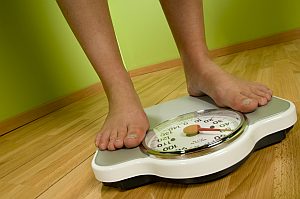Recharge Your Exercise Motivation
You Think: "The scale is stuck. Why bother?"
Rethink: "This pudge will budge."
Stick with the scale: Love it and you'll probably lose pounds. In a study at the University of Minnesota, Twin Cities, of 3,026 adults who were watching their waistlines, those who weighed themselves more frequently lost more weight over two years or regained fewer pounds. This research backs up the benefits of daily weigh-ins, but weekly may do the trick: Three-quarters of the successful long-term slimmers listed in the National Weight Control Registry step on the scale at least once a week. "Plateaus are part of the process," says Kim H. Miller, PhD, associate professor of health promotion at the University of Kentucky in Lexington. Stay motivated in the meantime by giving yourself credit for how much better your clothes fit and for improving your overall health.
Redo: Rev up your routine
"As your metabolism changes to accommodate your smaller size, you are going to have to change what you're doing to coax your body to keep responding and shedding fat," Miller says. If you're eating light already (around 1,500 calories a day), don't cut back more; turn up the intensity and/or increase the length of your workout session a smidge.
This will not only burn more calories but also increase your cardio capacity, meaning that everything feels easier to do, so you can keep exercising. Crank the resistance on your stationary bike, push the pace of your walk or run for one-minute intervals, or add step-ups or jumping jacks between sets of toning moves: The cardio-strength mix of circuit training burns 512 calories per hour, more than double that of lifting alone.
You Think: "I can't do another rep."
Rethink: "My biceps rock!"
Need a lift? Just psyching yourself up while you're strength training can increase your muscle power by 8 percent, according to a study from the School of Sport and Exercise Science at Wintec, Waikato Institute of Technology in New Zealand; you'll reap about 12 percent more power imagining those perfect lifts versus when you're distracted. Depending on how pooped your arms are, "mental imagery could help to activate additional motor units," says Brad Hatfield, PhD, professor of kinesiology at the University of Maryland in College Park, stimulating muscle fibers enough to help eke out more curls.
Redo: Dumb(bell) it down
If you can't muster more reps at the same weight, go lighter. Decrease the amount that you're lifting in 10 percent increments until you can finish the set with good form, suggests Juan Carlos Santana, director of the Institute of Human Performance gym in Boca Raton, Florida. "The bigger the effort, the bigger your body's response will be," he says. That means netting some 46 percent greater strength gains by doing two or three sets compared with only one, says a study in the Journal of Strength and Conditioning Research. And don't beat yourself up: Pushing your limits just a little further gets you firming results you'll feel, Santana says.
You Think: "Run a mile? Me? Not!"
Rethink: "Hey, doesn't that jogger look like Brad Pitt?"
When you're trying to slog through that first — or extra — mile, shift your attention to the things around you, says Alan St. Clair Gibson, PhD, MD, chair of sport sciences at Northumbria University in England: "You might slow down, but it will help you keep going." Also add a can-do mental mantra, like "I'm a running machine!" to put more mettle in your pedals.
Redo: Divide and conquer
Split your run into walking and running parts at first, says Joe Puleo, head cross country and track-and-field coach at Rutgers University in Camden, New Jersey, and coauthor of Running Anatomy. Jog a quarter of a mile, walk for half a mile, and finish by jogging another quarter. As you improve, stretch out the jogging and shrink the walking segment before jogging that final quarter mile. Do this three or four times a week and "you'll be able to run the whole distance in about six weeks," Puleo says.
Get started with a running routine
You Think: "I hurt my knee. There goes exercise for a month."
Rethink: "Pilates, here I come!"
Your body starts to lose conditioning within three days of your becoming a couch potato. If that ain't enough to light a fire under you, tell yourself that there's more than one way to reach your exercise goal, says Trent Petrie, PhD, director of the Center for Sport Psychology at the University of North Texas in Denton. "Write down all the negative things you're thinking, and next to those, reframe them into more positive statements," he says. For example, "What a downer; I can't kickbox" becomes "Oh, well, now I'll finally pop in that Abs of Steel workout DVD."
Redo: Pull a switcheroo
Dance class is out, but there are plenty of low- or no-impact exercise options that melt fat. Depending on your injury, moderate elliptical training (416 calories an hour), cycling (512 calories), or jogging in water (512 calories) can be an appropriate alternative, says Robert S. Gotlin, DO, director of orthopedic and sports rehabilitation at Beth Israel Medical Center in New York City and editor of Sports Injuries Guidebook. But if just bending your knee causes pain, Dr. Gotlin suggests shifting your cardio to your top half by using an upper body ergometer (a hand crank that you'll find in some gyms) or hitting a boxing bag. See your doc to be sure which route is best for you.
You Think: "Classes like Spinning and boot camp seem too intense for me."
Rethink: "That guy in bike shorts doesn't look so tough."
"Usually, we're afraid of the unknown," Petrie says, so testing the waters first will eventually allow you to dive in. Observe a class from the warm-up and beyond rather than peek in at the midpoint, when the action is sweatiest and most intimidating.
Redo: Go at your own pace
"The great thing about Spinning is that you control your experience," says instructor Kimberly Fowler, founder of YAS Fitness Centers in California. "If the instructor tells you to turn up the resistance, go to where you feel you can keep up; then if you get tired, lower it." (Psst! Those classmates who look like Lance Armstrong are probably doing the same.) In any group exercise class, your main goal is to get the hang of it, so aim for form over speed.
You Think: "Exercising at home is my only option: blechhh."
Rethink: "There's no place like home — to get a hot body."
First, identify what would give you the willpower to stay off the couch, "then make a plan to get you in the right frame of mind to commit to exercise," Petrie says. Put your workout clothes on so you know that exercising is the next thing to do after you fulfill your obligations, he says, whether those involve feeding the cat after work or taking the kids to school in the morning. Then create a workout schedule with built-in accountability: Recruit a friend to do fitness DVDs with on specific days or join a walking or running club (rrca.org) that meets regularly.
Redo: Order takeout
Beam a trainer to your living room for a fraction of the in-gym cost. At sites like fitorbit.com ($9.99 a week and up), trainers give you the drill-sergeant (or cheerleader or buddy) treatment by means of e-mail and their personal Web pages. Even celeb trainers, like Kim Lyons (kimlyons.com), formerly of The Biggest Loser, see clients via Internet sites. You can also get a customized routine and diet from FITNESS's online Personal Trainer that progressively challenges you on your way to Slimville ($39.99 for three months, $8.99 a month thereafter; or the free 10-day trial).
Try the FITNESS Personal Trainer
You Think: "Staying on a cardio machine for more than 30 minutes is slow torture."
Rethink: "Who'll be eliminated tonight on The Bachelorette?"
"Dedicate your treadmill time to doing things that you normally can't, such as watching your favorite TV show or listening to a new playlist or podcast," Petrie says. Start a few minutes before showtime so you'll be inspired to push past the 30-minute barrier to see how the episode ends.
Redo: Save the rest for last
Plan your workout so the end is all downhill, so to speak. In a study at the Department of Health and Exercise Science at the College of New Jersey in Ewing, treadmillers who did higher-intensity followed by lower-intensity exercise burned more fat and felt that their workouts were less stressful than when the order was reversed. Try it yourself on any cardio machine with this 45-minute plan from Los Angeles-based personal trainer Michael Berg.
The first 25 minutes: Warm up for five minutes at an easy pace. Then increase your speed to a moderate intensity, and for the next 20 minutes, up the incline or resistance 1 percent every two minutes.
The last 20 minutes: Lower the setting to an incline or resistance level that's comfortable but slightly challenging and do it for 15 minutes. Follow with a five-minute cool-down at an easy pace with the incline set on zero.
You Think: "I simply can't shake the after-work energy slump to exercise."
Rethink: "Just 10 minutes."
"There's a difference between being mentally tired and being physically tired," the University of Kentucky's Miller says. "Doing something physical will actually help combat some of the mental fatigue." Try Miller's trick to get your noggin on board: Tell yourself that you're not going to do more than 10 minutes of exercise. Often this leads to extending the time once you get into it, he notes. In a study at Northern Arizona University in Flagstaff, doing 10 minutes of moderate exercise, such as light pedaling on a stationary bike, was enough to improve mood and fatigue levels.
Redo: Stack the deck in your favor
Make the path home go through your gym, Miller suggests; not only will the sight of exercisers spark you to move, but you'll capitalize on the momentum of not having parked yourself on the recliner post-work. Also, have an alternative workout you can switch to if you're not feeling up to your usual routine or if you miss a class: Leave a workout DVD in the player at home or keep your yoga mat at the ready. Women in a study at Columbia University who had a written plan B exercised twice as much as those who didn't.
-
Detoxification Methods
There are millions of people in America who contend that body de
-
Follow This Weight Loss Timeline To A Tee For Results That Stick
A small study from the University of Copenhagen showed that if you can
-
Proactol - Try These Suggestions If You Want To Slim Down
Achieving a healthy weight for our bodies is really a goal that impac
-
Yoga Exercises For Weight Loss: The Best Way To Healthy & Fit Life
Losing weight is not an easy task. Shedding those extra pounds of fle
-
How Many Calories Activities Burn Daily -- 5 Weight Loss Tips For Burning Calories
When you are setting out to burn calories through everyday activities
-
Surgical Procedures For Losing Weight
Obesity has gradually emerged as a major issue of concern in the USA
- DON'T MISS
- How to Lose Belly Fat in 2 Weeks
- Losing Weight Is Tough, So Use These Tips To Make It Easy!
- 5 Reasons Most Diets Fail Within 7 Days
- 11 Quotes That Will Inspire You On Your Weight Loss Journey
- Weight Loss Tip #28 – Eat chillies to lose weight!
- Tips for Losing Weight on Low Carb Diet
- High Sugar Fruits and Better Choices:
- Need Help Losing Weight? Check Out These Tips!
- Best Weight Loss Tips For Men
- Fitness And Weight Loss With Diabetes




